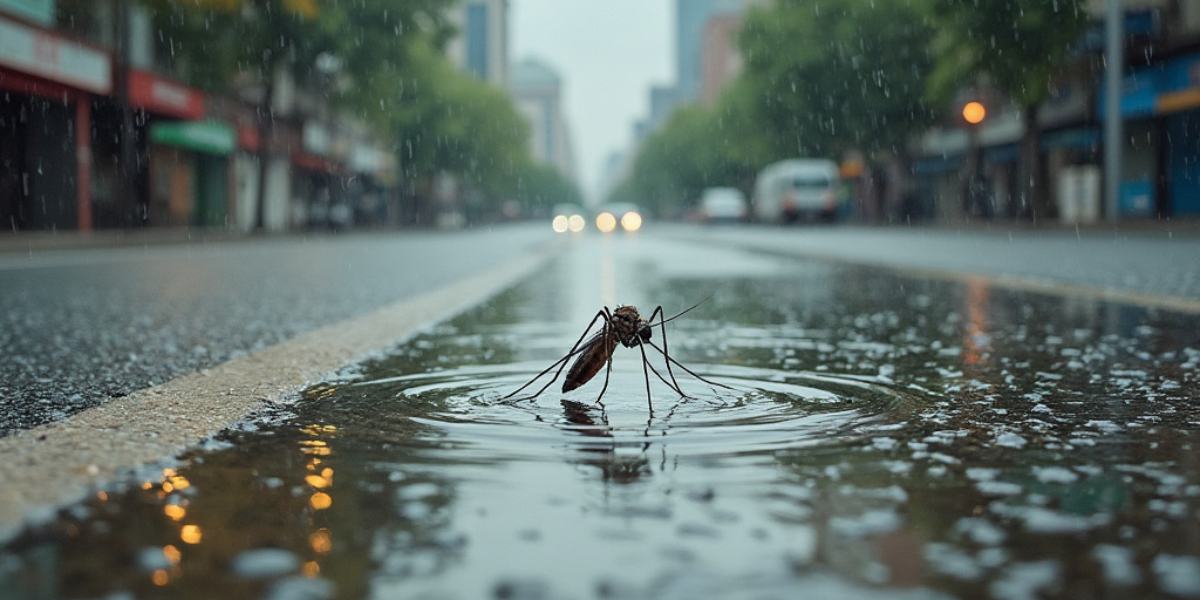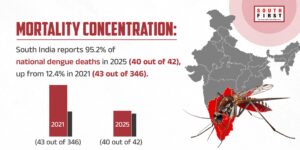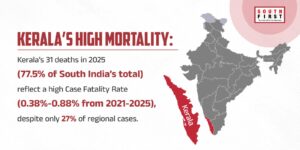The 2024 data reveals unprecedented surge patterns across south, with the region reporting 99,211 cases - highest annual burden in history.
Published Sep 26, 2025 | 7:00 AM ⚊ Updated Sep 26, 2025 | 7:23 AM

Representative image of a mosquito
Synopsis: South India now accounts for 61.8% of India’s dengue cases in 2025, with 30,628 cases and 95.2% of deaths, driven by Karnataka, Tamil Nadu, and Kerala. Climate, erratic monsoons, and rapid urbanisation fuel mosquito breeding, amplifying transmission. Kerala’s high mortality contrasts with Karnataka’s effective case management, highlighting regional disparities in healthcare response.
In 2021, if you picked 20 dengue patients randomly across India, only three would have been from the southern states. Fast forward to 2025, the ratio has dramatically shifted—now three out of every five dengue cases in the country originate from South India.
The latest data from the National Centre for Vector Borne Diseases Control (NCVBDC), accessed through RTI by South First, reveals a startling geographical concentration of dengue fever, with the south accounting for 30,628 cases out of the national total of 49,573 cases recorded till August 2025.
This represents a 61.8 percent share of the country’s dengue burden, a four-fold increase from the 15.6 percent share the region held in 2021 when it reported 30,204 cases out of 193,245 national cases.
This epidemiological shift extends beyond mere case numbers. The mortality pattern presents an even more alarming picture—South India now accounts for 40 out of 42 dengue deaths nationwide in 2025, representing 95.2 percent of all dengue fatalities. This marks a dramatic escalation from 2021, when the region contributed 43 deaths out of 346 national deaths, or just 12.4 percent of the total mortality burden.

South India reports 95.2% of national dengue deaths in 2025
The disease burden has not only intensified in absolute terms within South India but has also become increasingly regionalised, with northern and western states reporting comparatively fewer cases.
Within South, the disease burden distribution reveals distinct patterns among the seven states and union territories. Karnataka leads with 4,281 cases, followed closely by Telangana with 4,296 cases—though both states report zero deaths, indicating effective case management protocols.
Tamil Nadu follows with 11,825 cases and seven deaths, while Kerala presents a concerning picture with 8,259 cases but 31 deaths, the highest mortality count in the country.
Andhra Pradesh contributes 1,410 cases with two deaths, while the smaller territories of Puducherry and Lakshadweep report 478 and 79 cases respectively, both with zero fatalities.
“The mortality patterns vary significantly, pointing to differences in healthcare response capabilities and case management effectiveness across the region.
The five-year cumulative data from 2021-2025 reveals Karnataka as the overall case leader with 73,749 total cases, followed by Tamil Nadu with 60,793 cases and Kerala with 54,042 cases. However, when examining mortality, Kerala emerges as the most concerning, accounting for 368 deaths out of 481 total deaths in South India over the five-year period—representing 76.5 percent of all dengue deaths in the region.
The mortality landscape in South India presents a paradox of volume versus lethality. While Karnataka reports the highest case volumes consistently, its death toll remains relatively low, suggesting robust clinical management systems.
Conversely, Kerala, with moderate case numbers, shows persistently high mortality rates.

Karnataka leads with 4,281 cases (0 deaths), Telangana 4,296 (0 deaths), Tamil Nadu 11,825 (7 deaths), Kerala 8,259 (31 deaths), Andhra Pradesh 1,410 (2 deaths), Puducherry 478 (0 deaths), Lakshadweep 79 (0 deaths)
Kerala’s death toll of 31 in 2025 (till August) represents 77.5 percent of all dengue deaths in South India, despite accounting for only 27 percent of the region’s cases. This disproportionate mortality burden has been consistent across years, with Kerala’s Case Fatality Rate ranging from 0.38 percent to 0.88 percent between 2021-2025, significantly higher than other southern states.
Tamil Nadu, despite reporting the highest case numbers in 2025, maintains a relatively controlled mortality rate with seven deaths, yielding a CFR of 0.06 percent. Karnataka and Telangana, both major contributors to case numbers, report zero deaths in 2025, suggesting effective clinical protocols and healthcare infrastructure capable of managing large patient volumes without corresponding mortality increases.
Multiple interconnected factors have transformed South India into the country’s dengue epicentre.
The region’s tropical climate provides optimal breeding conditions, with warm temperatures ranging from 25-30°C and high humidity levels creating perfect environments for Aedes aegypti and Aedes albopictus mosquitoes—the primary dengue vectors.
The monsoon cycle plays a crucial role in disease transmission patterns. South India receives substantial rainfall during both southwest and northeast monsoon seasons, but it’s the pattern of precipitation that proves most problematic. Erratic or intermittent rainfall—periods of heavy rain followed by dry spells—leaves standing water in containers, construction sites, and debris, creating extensive breeding grounds. Studies demonstrate that rainfall and humidity levels show strong correlation with increased dengue cases after a lag period of 4-6 weeks.
Rapid urbanisation across southern states has occurred without corresponding improvements in drainage, sanitation, and waste management systems.
Cities like Bengaluru, Chennai, and Hyderabad face challenges with water storage practices, uncovered containers, and ongoing construction activity—all factors that multiply mosquito breeding opportunities. High population density in these urban centers increases human-mosquito contact rates, accelerating virus transmission.
The vector biology favors South India’s climate, where temperatures remain almost optimal year-round for mosquito survival and reproduction. Warmer temperatures reduce the extrinsic incubation period—the time required for virus replication inside mosquitoes before they become infectious—thereby speeding up transmission cycles.
Climate change has further extended the seasonal window for mosquito survival while increasing transmission potential through more frequent heavy rainfall events and temperature anomalies.
The epidemiological data identify distinct risk profiles among South Indian states. Kerala emerges as the highest-risk state, combining significant case volumes with consistently elevated mortality rates.
Tamil Nadu represents a high-volume, moderate-risk profile, with substantial case numbers but better mortality control. The state experienced a dramatic surge in 2024 with 27,378 cases—a 300 percent increase from 2023—yet managed to maintain relatively low death rates, suggesting healthcare system adaptability during crisis periods.
Karnataka and Telangana fall into the high-volume, low-risk category, demonstrating that large case numbers need not translate to high mortality if appropriate clinical management systems are in place. Both states have consistently maintained low CFRs despite handling substantial patient volumes, indicating effective healthcare responses and potentially better vector control measures.
The 2024 data reveals unprecedented surge patterns across South India, with the region reporting 99,211 cases—the highest annual burden in recorded history. This surge was led by Karnataka with 32,886 cases and Tamil Nadu with 27,378 cases, both representing significant increases from their previous year numbers.
The surge pattern appears to follow distinct state-specific trajectories. Karnataka showed steady growth from 7,393 cases in 2021 to its 2024 peak, while Tamil Nadu experienced explosive growth, jumping from 9,121 cases in 2023 to 27,378 in 2024. Kerala’s pattern shows more volatility, with significant increases in 2023 (17,426 cases) and 2024 (20,674 cases) before moderating in 2025.

Kerala registered high mortality compared to its neighbouring states
Telangana demonstrates a more stable pattern with consistent numbers around 8,000-10,000 cases annually, while Andhra Pradesh shows declining trends from its 2022 peak of 6,391 cases. These varying patterns suggest different underlying factors—climate, urbanisation, vector control effectiveness, or healthcare system responses—influencing dengue transmission across the region.
The 2025 partial-year data, covering only eight months, already show concerning numbers with 30,628 cases region-wide. If seasonal patterns hold, the final 2025 numbers could potentially match or exceed the 2024 surge, indicating that South India’s dengue burden may be reaching endemic levels rather than representing periodic epidemic spikes.
The elevated case detection rates in South India may also reflect improved surveillance and diagnostic capabilities compared to other regions. Better healthcare access and reporting systems in many southern states increase the likelihood of dengue case identification and documentation, potentially contributing to the higher reported numbers. However, this surveillance advantage is not uniform across all states, and underreporting continues in some areas.
Additionally, the circulation of multiple dengue virus serotypes creates complex immunological challenges. When different serotypes circulate simultaneously, prior immunity to one type can trigger more severe disease upon infection with another serotype through antibody-dependent enhancement.
While this doesn’t necessarily increase case numbers, it tends to increase disease severity and hospitalisations, thereby increasing detection rates and healthcare system burden—factors that may contribute to South India’s prominent position in national dengue statistics.
(Edited by Amit Vasudev)
